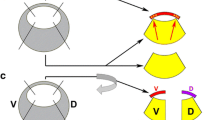Abstract
Xenopus mesoderm cells destined to form notochord have been isolated at various stages of gastrulation and cultured singly or in multicellular reaggregates in ectodermal sandwiches. When taken from mid gastrulae, singly implanted notochord progenitor cells can subsequently express the notochord marker MZ15. In contrast, the same cells taken from an early gastrula only do so when implanted as groups of such cells. We conclude that the community effect, first described for muscle differentiation, also applies to the notochord, and that the time in development when the notochord community effect is required precedes that for muscle.
Similar content being viewed by others
References
Cho KWY, Blumberg B, Steinbeisser H, De Robertis EM (1991) Molecular nature of Spemann's organizer: the role of the Xenopus homeobox gene goosecoid. Cell 67: 1111–1120
Gurdon JB (1977) Methods for nuclear transplantation in Amphibia. In: Stein G, Stein J (eds) Methods in Cell Biology 16, 125–139. Academic Press. New York
Gurdon JB (1988) A community effect in animal development. Nature 336: 772–774
Gurdon JB, Tiller E, Roberts J, Kato K (1993a) A community effect in muscle development. Current Biol 3: 1–11
Gurdon JB, Kato K, Lemaire P (1993b) The community effect, dorsalization and mesoderm induction. Current Op Genet Dev 3:662–667
Gurdon JB, Lemaire P, Kato K (1993) Community effects and related phenomena in development. Cell 75: 831–834
Hemmati-Brivanlou A, Harland RM (1989) Expression of an engrailed-related protein is induced in the anterior neural ectoderm of early Xenopus embryos. Development 106: 611–617
Holtfreter J (1933) Nachweis der Induktionsfähigkeit abgetöteter Keimteile. Isolations- und Transplantationsversuche. Arch Entw Mech Org (Roux) 128: 584–633
Hopwood ND, Pluck A, Gurdon JB, Dilworth SM (1992) Expression of XMyoD protein in early Xenopus laevis embryos. Development 114: 31–38
Jones E, Woodland HR (1987) The development of animal caps in Xenopus: a measurement of the start of animal competence to form mesoderm. Development 101: 557–563
Kato K, Gurdon JB (1993) Single-cell transplantation determines the time when Xenopus muscle precursor cells acquire a capacity for autonomous differentiation. Proc Natl Acad Sci USA 90:1310–1314
Nieuwkoop PD, Faber J (1956) Normal table of Xenopus laevis (Daudin). North-Holland Publishing Co., Amsterdam
Sive HL (1993) The frog prince-ss: a molecular formula for dorsoventral patterning in Xenopus. Genes Dev 7: 1–12
Slack JMW, Forman D (1980) An interaction between dorsal and ventral regions of the marginal zone in early amphibian embryos. J Embryol Exp Morph 56: 283–299
Smith JC, Watt FM (1985) Biochemical specificity of Xenopus notochord. Differentiation 29: 109–115
Smith WC, Harland RM (1992) Expression cloning of noggin, a new dorsalizing factor localized to the Spemann organizer in Xenopus embryos. Cell 70: 829–840
Taira M, Jamrich M, Good PJ, Dawid IB (1992) The LIM domain-containing homeobox gene Xlim-1 is expressed specifically in the organizer region of Xenopus gastrula embryos. Gen Dev 6:356–366
Author information
Authors and Affiliations
Additional information
Correspondence to: J.B. Gurdon
Rights and permissions
About this article
Cite this article
Weston, M.J., Kato, K. & Gurdon, J. A community effect is required for amphibian notochord differentiation. Roux's Arch Dev Biol 203, 250–253 (1994). https://doi.org/10.1007/BF00360520
Received:
Accepted:
Issue Date:
DOI: https://doi.org/10.1007/BF00360520




